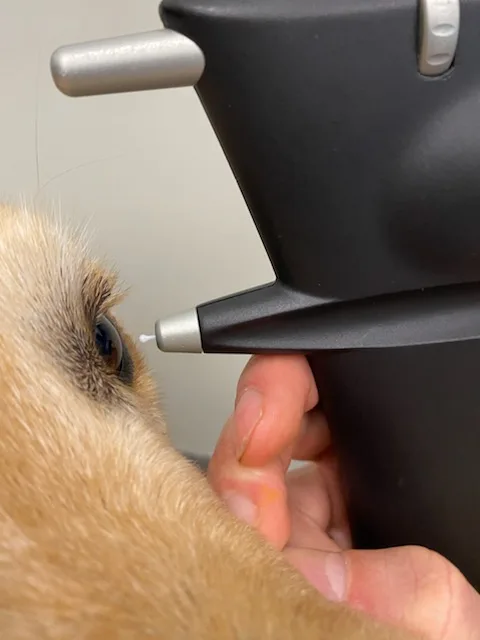Tonometry Technique Tips
Georgina M. Newbold, DVM, DACVO, The Ohio State University
In the literature
Pe’er O, Chiu E, Arad D, Lelescu C, Ross M, Ofri R. Does the order of intraocular pressure measurement affect tonometry results? Vet Ophthalmol. 2021;24(S1):146-153.
The Research ...
Tonometry is a critical test in diagnosing and monitoring conditions such as glaucoma or uveitis and should be performed in all dogs with a red eye. Normal intraocular pressure (IOP) in dogs is reported1,2 as 15 to 25 mm Hg; readings that differ >20% between the right and left eye may be abnormal.
Most tonometers work by the principles of applanation (ie, force needed to flatten a specific area of cornea) or rebound (ie, analysis of motion parameters of a bouncing probe). Applanation tonometry requires a topical anesthetic, whereas rebound tonometry does not.
Restraint and patient positioning can affect tonometer readings. Any external pressure on the globe, eyelids, or neck (eg, jugular vein compression) can artifactually increase IOP.
This study evaluated 72 normal dogs using either applanation or rebound tonometry. IOP readings taken in the second eye were significantly lower than in the first eye, regardless of which eye was measured first (ie, left vs right) or the type of tonometer used. Measurements repeated in the first eye were also lower than the initial reading. This phenomenon was reproducible 15 minutes later, with readings lower than the initial set. These findings suggest that, in normal dogs, the IOP of the fellow eye will be slightly lower than that of the first eye and repeated measurements may yield further decreased IOP readings.
Most readings differed by an average of <2 mm Hg and were <20% different between eyes, which is considered clinically insignificant; however, some individual readings differed by 5 to 8 mm Hg, representing up to a 30% difference. Although this could be interpreted as a clinically significant difference, it may simply be the result of the order in which IOP was measured.
It is unclear what exactly causes decreased IOP readings in the second eye and in repeated measurements in the first eye. In humans, a “white coat” phenomenon has been noted in which stress and anxiety can raise IOP and acclimatization and relaxation of the patient can lower IOP3; this may also apply to dogs. Other theories include mechanical changes in the fluid outflow of the eye, tear film changes, or additional factors related to tonometry itself.

Rebound tonometry in a dog
... The Takeaways
Key pearls to put into practice:
When performing tonometry, regardless of device used, it is important to use careful patient restraint and avoid pressure on the globe, eyelids, and neck to avoid iatrogenically increased IOP readings.
IOP readings in the first eye are often slightly higher than in the second eye. If the difference between eyes is >20% or appears to be elevated in the first eye, repeating the IOP reading should be considered before deciding on treatment.
When monitoring patients with glaucoma or uveitis, it is important to use the same equipment and consider the order of tonometry reading at each visit to maintain consistency.